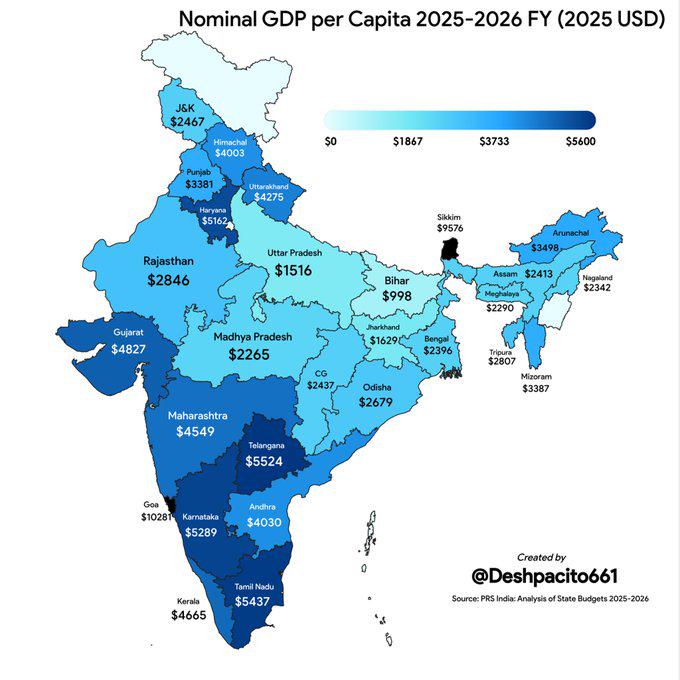India Nominal GDP per Capita by State Map


Marcus Rodriguez
Historical Geography Expert
Marcus Rodriguez specializes in historical cartography and geographic data analysis. With a background in both history and geography, he brings unique...
Geographic Analysis
What This Map Shows
The visualization titled "India Nominal GDP per Capita for States 2025-2026 FY (2025 USD)" presents a detailed overview of the projected nominal GDP per capita across India's states. This map serves as a crucial tool for understanding economic disparities within the country, allowing viewers to see how each state's economic performance is anticipated to compare in the fiscal year 2025-2026. By examining this map, one can gain insights into the economic landscape of India, revealing the states that are expected to thrive and those that may face challenges in terms of economic growth.
Deep Dive into Nominal GDP per Capita
Nominal GDP per capita is a significant economic indicator that measures the average economic output per person, without adjusting for inflation. It reflects the overall economic health of a region and provides valuable insights into the standard of living. In the context of India, understanding nominal GDP per capita is essential for several reasons. Firstly, it helps in assessing the economic well-being of citizens across different states. For instance, states like Maharashtra and Tamil Nadu are often at the top of the list due to their robust industrial sectors and urban development, while others like Bihar and Uttar Pradesh may lag behind due to various socio-economic factors.
Interestingly, the variations in GDP per capita across states can often be attributed to diverse factors such as industrialization levels, agricultural output, educational development, and infrastructure. States with thriving industries, like Gujarat known for its manufacturing and service sectors, generally report higher GDP per capita than those that rely heavily on agriculture or have less economic diversification. Furthermore, states that invest in education and skill development tend to see a more skilled workforce, which can contribute to higher productivity and, subsequently, a higher GDP per capita.
Have you ever wondered how the economic landscapes of India's states can impact migration patterns? People often move from lower GDP per capita states to those with higher figures in search of better opportunities. This movement can lead to urbanization, where cities in economically prosperous states experience rapid growth, while rural areas in less affluent states might struggle to sustain their populations.
Statistically, as of 2025, Maharashtra is expected to lead with a nominal GDP per capita of approximately $4,500, followed closely by Delhi and Tamil Nadu, both projected to hover around the $4,000 mark. In contrast, states like Bihar may have a GDP per capita as low as $1,500, reflecting the ongoing challenges in development and economic opportunities in those regions. This stark contrast illustrates the economic divide that exists within the country, raising essential questions about resource allocation, investment, and policy-making.
Regional Analysis
When breaking down the map by regions, several patterns emerge. For instance, the western states, particularly Gujarat and Maharashtra, showcase impressive economic growth driven by industrialization and trade. Gujarat's vibrant economy is bolstered by its strategic coastal location, facilitating robust export activities. Maharashtra, with Mumbai as its financial capital, benefits from a diverse economy that encompasses finance, entertainment, and technology.
In contrast, the northern states, such as Punjab and Haryana, while traditionally strong in agriculture, are now diversifying their economies. Punjab, once a major agricultural hub, is slowly transitioning to manufacturing and services, yet still lags behind in GDP per capita compared to its western counterparts. Meanwhile, the southern states, including Karnataka and Kerala, present an interesting mix; Karnataka's tech boom in Bengaluru contributes to its higher GDP per capita, while Kerala's focus on tourism and remittances from overseas workers plays a crucial role in its economic performance.
Interestingly, the northeastern states often demonstrate a unique economic landscape, with states like Assam and Tripura focusing on agriculture and natural resources. However, these states face challenges such as infrastructure deficits and limited industrial development, which inhibit their GDP growth potential.
Significance and Impact
Understanding the nominal GDP per capita across Indian states is not merely an academic exercise; it has significant real-world implications. Policymakers can use this information to identify regions in need of economic support and to allocate resources more effectively. Furthermore, this data can aid in setting development goals and measuring progress over time.
As we look toward the future, it is essential to consider trends such as the rise of technology and service industries, which are reshaping the economic landscape. The COVID-19 pandemic has also underscored the importance of resilient economic strategies, urging states to diversify their economies further.
In conclusion, the map of India's nominal GDP per capita for 2025-2026 doesn't just illustrate economic numbers; it tells a story of growth, challenges, and opportunities. By understanding these dynamics, we can better appreciate the complex tapestry of India's economy and the lives of its citizens.
Visualization Details
- Published
- October 7, 2025
- Views
- 62
Comments
Loading comments...